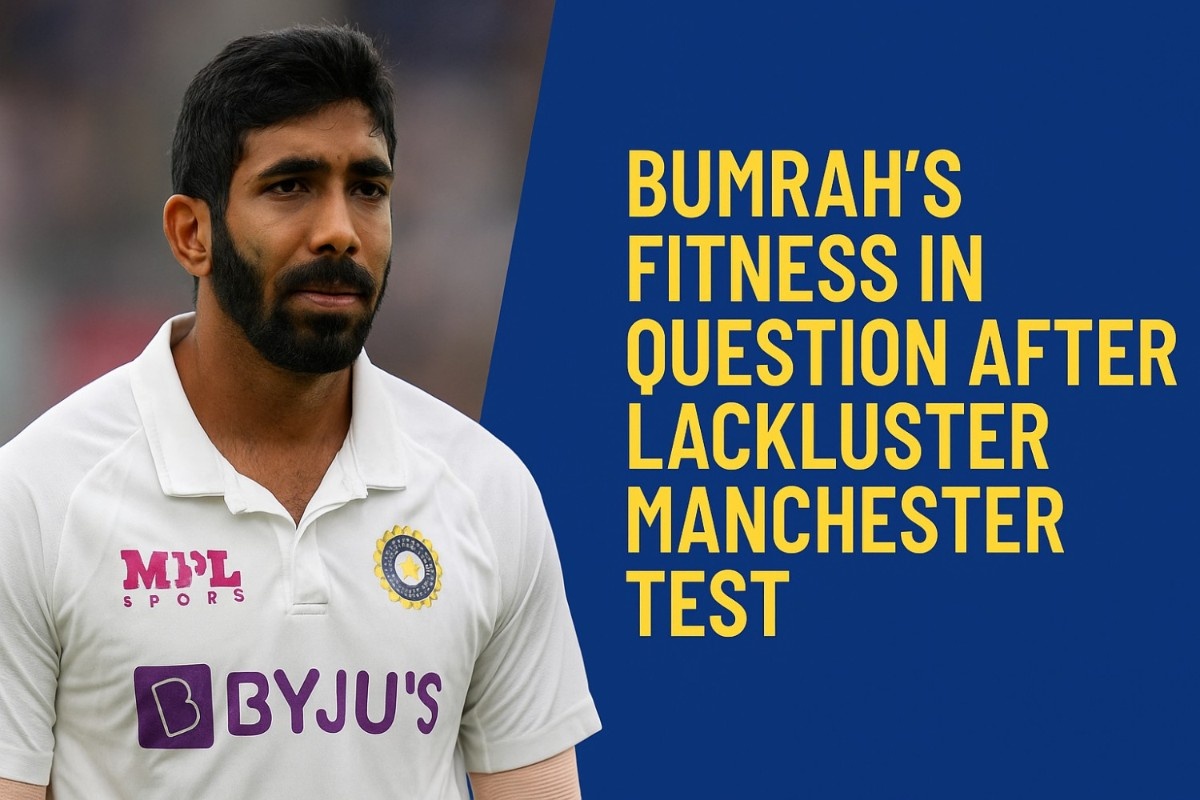Jasprit Bumrah, India’s premier fast bowler, is once again at the center of fitness debates. His recent outing in the Manchester Test against England has raised more questions than answers. Bumrah failed to display his usual firepower, looking unusually fatigued and low on rhythm. His pace was down, accuracy missing, and body language visibly tired.
Bumrah generally bowls at speeds between 138 to 142 KMPH. However, in the Manchester Test, not a single delivery clocked above 140. This is unusual for someone known for sharp, skiddy pace and brutal consistency. Fans and experts alike were quick to notice the difference.
No Zip, No Rhythm – What Happened to Bumrah?
Bumrah bowled 23 overs in England’s first innings and went wicketless, conceding 79 runs. He eventually got a breakthrough in the 24th over, dismissing Jamie Smith. But by then, England had already stabilized their innings. More concerning was the drop in energy that Bumrah showed throughout his spells.
His line and length were far from perfect. Bumrah bowled several deliveries on the leg side and many short of a good length. His usual tight control was missing. He often struggled to generate swing or bounce, looking one-dimensional at times.
Former England captain Michael Vaughan also pointed out Bumrah’s dip in intensity. Vaughan remarked that the sharpness visible in Lord’s Test was nowhere to be seen at Old Trafford.
Signs of Physical Strain and Fatigue
A major turning point came when India took the second new ball. Captain Shubman Gill handed the ball to Bumrah, but he bowled only one over before walking off the field. Though he did return later, the moment sparked fresh concerns. It was clear that Bumrah’s body wasn’t holding up well.
The incident fueled speculation over his fitness. Has Bumrah truly recovered from his long-standing back injury? Has the team pushed him too far, too soon? These questions loom large after the Manchester performance.

The Lingering Impact of Back Injury
Bumrah suffered a major back injury during the Sydney Test against Australia in January. Although he made a comeback during IPL 2025, the tournament’s short format meant he bowled a maximum of just 4 overs per game. Test cricket, however, demands longer spells, mental endurance, and consistent physical strain.
Before the series began, it was decided that Bumrah would play only three Tests. Head coach Gautam Gambhir confirmed this in a press conference. However, injuries to Arshdeep Singh and Akash Deep forced the team to play Bumrah in Manchester as well.
The result was visible on the field. Bumrah looked half-ready, half-recovered. His body language never reflected full comfort. Unlike his dominant spells at Lord’s and Leeds, he never really looked threatening.
Previous Tests Showed a Different Bumrah
In the first two matches of the series, Bumrah was in prime form. He grabbed a five-wicket haul each in the Leeds and Lord’s Tests. With 12 wickets to his name, Bumrah was leading India’s pace attack. His fiery spells helped India stay in contention and often broke crucial partnerships.
However, the Manchester Test was a different story. Expectations were high, and India needed Bumrah to deliver. But he simply couldn’t rise to the challenge. He lacked energy, penetration, and pace. And in Test cricket, these three things make or break a fast bowler.
Workload Management Is Now More Crucial Than Ever
Fast bowlers need careful workload management. With the number of matches increasing, proper rest and recovery cycles are vital. Bumrah has already had a tough history with injuries. If not managed well, his longevity in Test cricket may be affected.
The Manchester Test showed us a Bumrah who probably needed rest more than anything. His inclusion in the match looked more like a forced decision. With no experienced pacers left in the squad, India had no choice but to field him.
Now, all signs point to Bumrah skipping the final Test at The Oval. That match starts on July 31. Given that he has already played three grueling Tests, the team may rest him for recovery and preparation ahead of future series.
Bumrah’s Role in Team India’s Future
Bumrah is not just another fast bowler. He’s a leader, a match-winner, and arguably the most lethal weapon in India’s bowling arsenal. But that status comes with responsibility — not just from Bumrah but also from the team management.
India must ensure that Bumrah is protected from burnout. He should be allowed to fully recover before playing long-format games. Bumrah’s presence is crucial in big tournaments, and risking him unnecessarily could cost the team dearly.
The Test series against England showed two versions of Bumrah — the dominator and the exhausted. The latter should serve as a red flag for selectors and physiotherapists alike.
Conclusion: Time to Prioritize Bumrah’s Recovery
There’s no doubt about Bumrah’s talent and hunger. But the human body has limits. The Manchester Test was a clear indicator that Bumrah needs recovery time. India cannot afford to lose him to recurring injuries again.
Resting him for the Oval Test might be a wise decision. This would allow him time to reset, recover, and return stronger. Bumrah is too valuable a resource to be risked without full fitness.
As fans, all we can do is hope that this is just a temporary phase. Jasprit Bumrah has bounced back before — and he can do it again. But for now, his health must come first.
